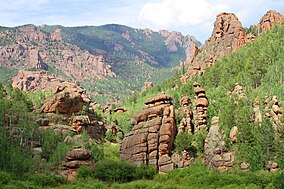Lost Creek Wilderness
| Lost Creek Wilderness | |
|---|---|
|
IUCN category Ib (wilderness area)
|
|

Lost Creek Wilderness
|
|
| Location | Park / Jefferson counties, Colorado, USA |
| Nearest city | Denver, CO |
| Coordinates | 39°16′7″N 105°28′5″W / 39.26861°N 105.46806°WCoordinates: 39°16′7″N 105°28′5″W / 39.26861°N 105.46806°W |
| Area | 119,790 acres (484.8 km2) |
| Established | January 1, 1980 |
| Governing body | U.S. Forest Service |
The Lost Creek Wilderness is a 119,790-acre (485 km2) wilderness area located in central Colorado in Jefferson and Park counties south of the town of Bailey. The area is situated entirely within the boundaries of the Pike National Forest.
The Lost Creek Scenic Area in the Wilderness is a 16,798 National Natural Landmark designated site.
The area is named for Lost Creek, a perennial stream that disappears and reappears before finally joining Goose Creek which empties into the South Platte River at Cheesman Reservoir just east of the Wilderness area. The entire water system of the area forms a watershed for the Platte River Basin. The area is notable for its many rock formations, natural arches, and rounded granite domes and knobs,. These are contained in two ranges of low alpine foothills of the Rocky Mountains: the Kenosha Mountains and the Tarryall Mountains. 12,431-foot (3,789 m) Bison Peak is the highest peak in the wilderness.
Because of its proximity to Denver, the area is quite popular for outdoor recreation in both summer and winter months. Typical activities in the area include hiking, backpacking, rock-climbing, as well as cross-country skiing, snowshoeing and winter camping. There are 130 miles (210 km) of trails in the wilderness, including a section of the Colorado Trail that crosses Lost Creek then parallels the northeast boundary toward Kenosha Pass.
...
Wikipedia

